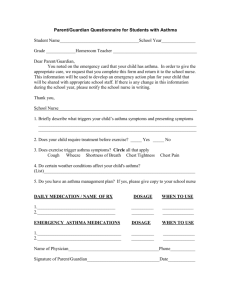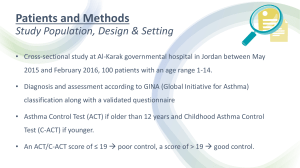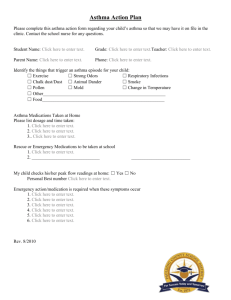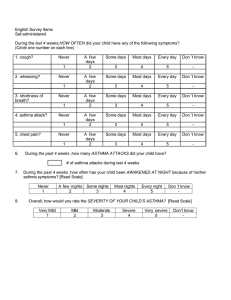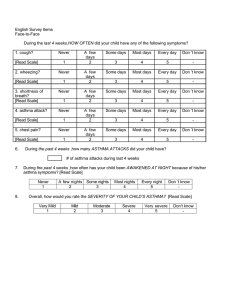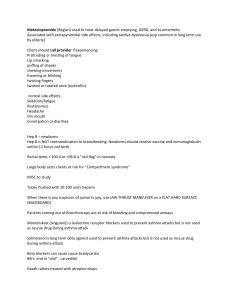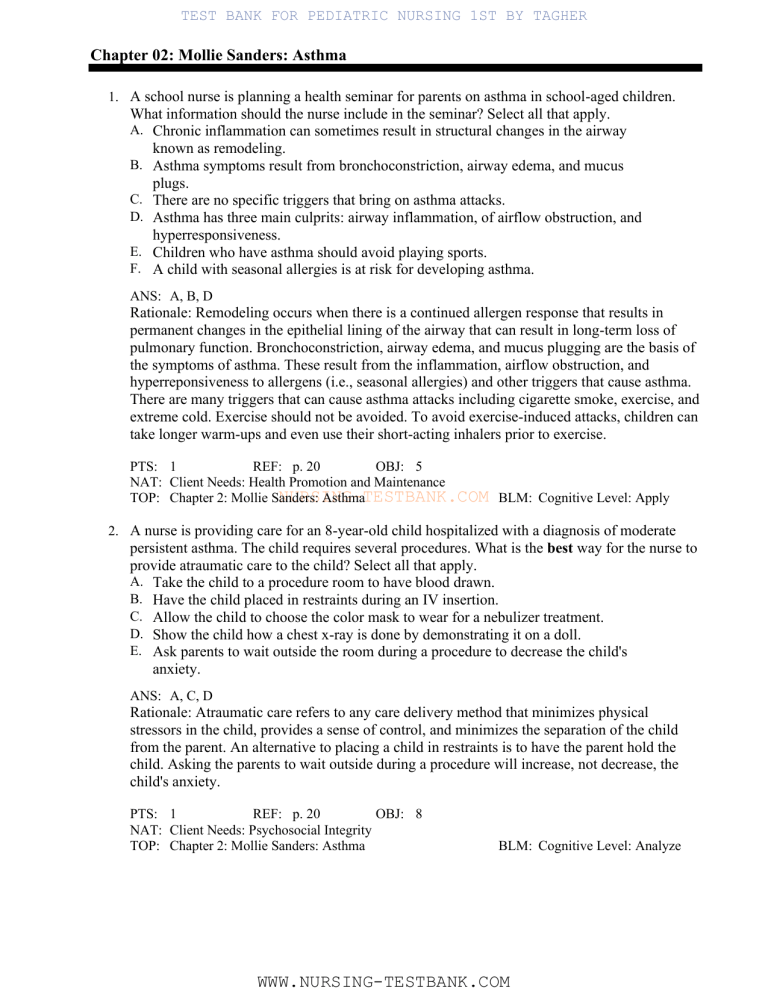
TEST BANK FOR PEDIATRIC NURSING 1ST BY TAGHER Chapter 02: Mollie Sanders: Asthma 1. A school nurse is planning a health seminar for parents on asthma in school-aged children. What information should the nurse include in the seminar? Select all that apply. A. Chronic inflammation can sometimes result in structural changes in the airway known as remodeling. B. Asthma symptoms result from bronchoconstriction, airway edema, and mucus plugs. C. There are no specific triggers that bring on asthma attacks. D. Asthma has three main culprits: airway inflammation, of airflow obstruction, and hyperresponsiveness. E. Children who have asthma should avoid playing sports. F. A child with seasonal allergies is at risk for developing asthma. ANS: A, B, D Rationale: Remodeling occurs when there is a continued allergen response that results in permanent changes in the epithelial lining of the airway that can result in long-term loss of pulmonary function. Bronchoconstriction, airway edema, and mucus plugging are the basis of the symptoms of asthma. These result from the inflammation, airflow obstruction, and hyperreponsiveness to allergens (i.e., seasonal allergies) and other triggers that cause asthma. There are many triggers that can cause asthma attacks including cigarette smoke, exercise, and extreme cold. Exercise should not be avoided. To avoid exercise-induced attacks, children can take longer warm-ups and even use their short-acting inhalers prior to exercise. PTS: 1 REF: p. 20 OBJ: 5 NAT: Client Needs: Health Promotion and Maintenance NURSI NG-TESTBANK.COM BLM: Cognitive Level: Apply TOP: Chapter 2: Mollie Sanders: Asthma 2. A nurse is providing care for an 8-year-old child hospitalized with a diagnosis of moderate persistent asthma. The child requires several procedures. What is the best way for the nurse to provide atraumatic care to the child? Select all that apply. A. Take the child to a procedure room to have blood drawn. B. Have the child placed in restraints during an IV insertion. C. Allow the child to choose the color mask to wear for a nebulizer treatment. D. Show the child how a chest x-ray is done by demonstrating it on a doll. E. Ask parents to wait outside the room during a procedure to decrease the child's anxiety. ANS: A, C, D Rationale: Atraumatic care refers to any care delivery method that minimizes physical stressors in the child, provides a sense of control, and minimizes the separation of the child from the parent. An alternative to placing a child in restraints is to have the parent hold the child. Asking the parents to wait outside during a procedure will increase, not decrease, the child's anxiety. PTS: 1 REF: p. 20 OBJ: 8 NAT: Client Needs: Psychosocial Integrity TOP: Chapter 2: Mollie Sanders: Asthma BLM: Cognitive Level: Analyze WWW.NURSING-TESTBANK.COM TEST BANK FOR PEDIATRIC NURSING 1ST BY TAGHER 3. A school-aged child has been hospitalized for an asthma exacerbation. The child is receiving oxygen via nasal cannula at 2 liters per minute. The nurse wants to provide a form of distraction to the child. What activity would be most appropriate for the nurse to offer the child? Select all that apply. A. Large, brightly colored blocks B. A visit to the unit's library C. Several coloring books and crayons D. Hand puppets E. Playing hide and seek with a roommate ANS: B, C Rationale: Large, brightly colored blocks and hand puppets would be better choices for preschoolers or toddlers. Playing hide and seek with a roommate would be inappropriate given the child's current condition. Reading and coloring are age-appropriate activities for a school-aged child. PTS: 1 REF: p. 27 OBJ: 1 NAT: Client Needs: Psychosocial Integrity TOP: Chapter 2: Mollie Sanders: Asthma BLM: Cognitive Level: Apply 4. NURSING-TESTBANK.COM An 8-year-old girl is seen in the clinic for a well-child visit. The nurse has completed an initial assessment with the above findings. Which assessment finding requires intervention? A. Weight B. Height C. Heart rate D. Blood pressure ANS: A WWW.NURSING-TESTBANK.COM TEST BANK FOR PEDIATRIC NURSING 1ST BY TAGHER Rationale: An 8-year-old girl who weighs 95 lb (43 kg) has a BMI of 23.3, which is above the 95th percentile for girls. This places the child at risk for obesity. The other assessment findings are normal. PTS: 1 REF: p. 18 OBJ: 1 NAT: Client Needs: Physiological Integrity: Reduction of Risk Potential TOP: Chapter 2: Mollie Sanders: Asthma BLM: Cognitive Level: Analyze 5. During a well-child visit, a nurse is providing teaching on child safety to the parent of a 9-year-old child. Which statement made by the parent indicates a need for additional teaching? A. "No one smokes in our home, so I have not discussed it with my child." B. "I am acquainted with my child's friends and their parents." C. "I have set screen time limits on all my child's electronic devices." D. "My child is good about sitting in the back seat and wearing a seat belt." ANS: A Rationale: Even though no one smokes in the household, the child may still be exposed to others outside the home that smoke and will require information about the hazards of tobacco use. The other statements indicate that teaching has been effective. Parents should set limitations on the amount of screen time their child has; children should sit in the back seat until age 13; it is important for parents to know their child's friends as well as the friends' parents. PTS: 1 REF: p. 22 OBJ: 2 NAT: Client Needs: Health Promotion and Maintenance TOP: Chapter 2: Mollie Sanders: Asthma NURSING-TESTBANK.COM BLM: Cognitive Level: Apply 6. An 8-year-old child diagnosed with asthma is being taught how to use a spacer with an albuterol inhaler. What is the best way for the nurse to evaluate the child's understanding of how to use the spacer? A. Guide the child step by step through the process. B. Have the child attach the spacer to the inhaler and use it. C. Have the child verbalize how to use the spacer. D. Attach the spacer to the inhaler, then have the child to use it. ANS: B Rationale: The best way to evaluate the child's understanding of the teaching is to have the child give a return demonstration of the task. Having the child verbalize the use of the spacer does not ensure that the child can actually use it correctly. Neither having the child attach the spacer nor the nurse attaching the spacer for the child allows the nurse to evaluate the teaching. PTS: 1 REF: p. 22 OBJ: 7 NAT: Client Needs: Physiological Integrity: Pharmacological and Parenteral Therapies TOP: Chapter 2: Mollie Sanders: Asthma BLM: Cognitive Level: Analyze 7. A nurse is caring for a 9-year-old child experiencing a severe asthma exacerbation with a dry hacking cough and wheezing. The child's pulse oximeter reading is 88% (0.88). What is the nurse's priority in caring for the child? A. Suction the nasopharynx. WWW.NURSING-TESTBANK.COM TEST BANK FOR PEDIATRIC NURSING 1ST BY TAGHER B. Administer oxygen as prescribed. C. Auscultate the lungs. D. Educate the family on the plan of care. ANS: B Rationale: The nurse's priority is to administer oxygen to improve the child's oxygen saturation in the blood (think airway, breathing, and circulation). The child has a dry cough so there is no indication to suction the nasopharynx. The nurse will need to auscultate the lungs and educate the family, but the priority is administering oxygen to improve gas exchange. PTS: 1 REF: p. 28 OBJ: 7 NAT: Client Needs: Safe, Effective Care Environment: Management of Care TOP: Chapter 2: Mollie Sanders: Asthma BLM: Cognitive Level: Apply 8. A nurse is providing teaching to a school-aged child about medications the child will use to manage asthma. Which medication should the nurse teach the child to use when acute symptoms occur? A. Montelukast B. Prednisone C. Albuterol D. Theophylline ANS: C Rationale: Albuterol is a fast-acting beta-adrenergic agonist used to manage acute asthma symptoms. Prednisone is an oral corticosteroid used to suppress inflammation; montelukast is a leukotriene receptor antagonist used to decrease the inflammatory response of leukotrienes; theophylline is used to relax the airway in moderate to severe asthma. NURSING-TESTBANK.COM PTS: 1 REF: p. 22 OBJ: 7 NAT: Client Needs: Physiological Integrity: Pharmacological and Parenteral Therapies TOP: Chapter 2: Mollie Sanders: Asthma BLM: Cognitive Level: Apply 9. A nurse is caring for a10-year-old child diagnosed with severe asthma. The health care provider has prescribed intravenous methyl-prednisolone. Based on this information, the nurse should be alert for what potential adverse effect? A. Nasal congestion B. Nervousness C. Decreased inflammation D. Hyperglycemia ANS: D Rationale: Methyl-prednisolone is a corticosteroid used to decrease inflammation. A potential adverse effect of the medication is hyperglycemia. Decreased inflammation is a desired effect; nasal congestion and nervousness are not adverse effects related to methyl-prednisolone that the nurse should monitor. PTS: 1 REF: p. 20 OBJ: 8 NAT: Client Needs: Physiological Integrity: Pharmacological and Parenteral Therapies TOP: Chapter 2: Mollie Sanders: Asthma BLM: Cognitive Level: Analyze WWW.NURSING-TESTBANK.COM TEST BANK FOR PEDIATRIC NURSING 1ST BY TAGHER 10. A nurse is caring for an 8-year-old child who was admitted 1 hour ago with a diagnosis of asthma exacerbation. The nurse has completed an assessment with the above findings. The nurse calls the health care provider to report the findings with what expectation(s)? Select all that apply. A. The current treatment regimen will be continued. B. The child will be transferred the NURSItoNG -Tintensive ESTBAcare NK.unit. COM C. A nebulizer treatment will be prescribed. D. The amount of oxygen administered will be increased. E. Blood cultures will be drawn. ANS: C, D Rationale: Because the oxygen saturation is only 89% on 2 liters of O2, the expectation is that the O2 will be increased so that the oxygen saturation will improve. Nebulizer treatments will help open the child's bronchioles and decrease the wheezing. In this case the current treatment regimen will not be continued; at this point, there is no indication to transfer to the intensive care unit; a low-grade temperature is not an indication to draw blood cultures. PTS: 1 REF: p. 20 OBJ: 8 NAT: Client Needs: Physiological Integrity: Reduction of Risk Potential TOP: Chapter 2: Mollie Sanders: Asthma BLM: Cognitive Level: Analyze 11. A child hospitalized with a diagnosis of asthma has received two albuterol nebulizer treatments back to back. The child reports feeling nervous. What action should the nurse take? A. Explain that this is a normal side effect to the medication in the nebulizer. B. Assure the child that there is nothing to be nervous about. C. Perform a fingerstick to check the glucose level. D. Ask the health care provider to change the nebulizer medication. ANS: A WWW.NURSING-TESTBANK.COM TEST BANK FOR PEDIATRIC NURSING 1ST BY TAGHER Rationale: Feeling nervous or jittery is a common side effect of albuterol, a short acting beta-adrenergic agonist. Assuring the child there is nothing to be nervous about is not true. The child's nervousness does not warrant checking the glucose level, and there is no need to ask the health care provider to change the medication. PTS: 1 REF: p. 22 OBJ: 7 NAT: Client Needs: Physiological Integrity: Pharmacological and Parenteral Therapies TOP: Chapter 2: Mollie Sanders: Asthma BLM: Cognitive Level: Apply 12. A health care provider has prescribed methylprednisolone 1.5 mg/kg/day in three divided doses for a child diagnosed with asthma. The child weighs 60 lb (27.27 kg). How many milligrams should the nurse administer in each dose? Record your answer using one decimal place. ANS: 13.6 Rationale: Use the client's weight in kilograms. 27.27 kg x 1.5 mg = 40.9 mg/day 40.9 mg ÷ 3 doses = 13.6 mg per dose Question format: Fill in the Blank PTS: 1 REF: p. 27 OBJ: 7 NAT: Client Needs: Physiological Integrity: Pharmacological and Parenteral Therapies TOP: Chapter 2: Mollie Sanders: Asthma BLM: Cognitive Level: Apply 13. A nurse is reviewing the health records of a child newly diagnosed with asthma. What NURSING-TESTBANK.COM information should the nurse expect to find that is consistent with the diagnosis? Select all that apply. A. Two hospitalizations as an infant for bronchiolitis B. Gestational age of 38 weeks at birth C. Parental decline of the flu vaccine for the child D. Received the DTaP vaccine at the last well-child visit E. Family cat named Tabby ANS: A, E Rationale: Being exposed to pet dander and a history of bronchiolitis are risk factors for developing asthma. A gestational age of 38 weeks is not a risk factor for asthma. Birth at 38 weeks' gestation is considered full term. Receiving the DTaP vaccine also is not a risk factor for asthma; however, it is not unusual for children to develop a low-grade fever or malaise as a side effect. Declining the flu vaccine is not a risk factor for bronchiolitis but it does place the child at risk for contracting the flu, which could complicate an existing case of bronchiolitis. PTS: 1 REF: p. 22 OBJ: 6 NAT: Client Needs: Health Promotion and Maintenance TOP: Chapter 2: Mollie Sanders: Asthma BLM: Cognitive Level: Apply 14. A nurse has provided teaching to a school-aged child on early signs of an impending asthma attack. Which statement made by the child is the best indicator that the nurse's instruction was effective? A. "Chest tightness or feeling short of breath means I could have an attack." WWW.NURSING-TESTBANK.COM TEST BANK FOR PEDIATRIC NURSING 1ST BY TAGHER B. "Wheezing is an early sign that an attack is coming." C. "I could have an attack soon if I start to cough up mucus." D. "A lot of sneezing means I am about to have an attack." ANS: A Rationale: Chest tightening and shortness of breath are early signs that an asthma attack is coming. Wheezing and coughing up mucus are worsening symptoms. Sneezing in and of itself does not indicate an asthma attack. PTS: 1 REF: p. 22 OBJ: 7 NAT: Client Needs: Health Promotion and Maintenance TOP: Chapter 2: Mollie Sanders: Asthma BLM: Cognitive Level: Apply 15. The parents of a child diagnosed with asthma asks the nurse how and why the disease affects their child's body the way it does. The nurse's response is based on which statement(s)? Select all that apply. A. The core of asthma's pathophysiology is inflammation. B. The smaller diameter of the child's trachea makes it more susceptible to obstruction. C. Inflammation results in bronchoconstriction, airway edema, and mucus plugging. D. Severe viral or bacterial respiratory infections can lead to the development of asthma. E. Children have larger tongues and longer airways than an adult. ANS: A, B, C, D Rationale: The main culprit in asthma pathophysiology is inflammation, which results in airway edema and bronchoconstriction, as well as mucus plugging. Respiratory infections NURvirus SINand G-T ESTBANKare .Crisk OM factors for later development of such as respiratory syncytial bronchiolitis asthma. Children have larger tongues in relation to their oral cavity and smaller airway diameters than adults that predispose them to obstruction. Children have shorter airways than adults. PTS: 1 REF: p. 26 OBJ: 3 NAT: Client Needs: Health Promotion and Maintenance TOP: Chapter 2: Mollie Sanders: Asthma BLM: Cognitive Level: Apply 16. A nurse is providing care for an 8-year-old child diagnosed with a severe asthma exacerbation. The child is receiving oxygen therapy, albuterol nebulizer treatments, and intravenous methylprednisolone. Based on this information, which laboratory result should the nurse monitor? A. Calcium B. Sodium C. Magnesium D. Glucose ANS: D Rationale: Methylprednisolone is a corticosteroid that can cause hyperglycemia. Therefore, the nurse should monitor the client's blood glucose. Albuterol and methylprednisolone do not have side effects associated with calcium, sodium, or magnesium. PTS: 1 REF: p. 20 OBJ: 8 NAT: Client Needs: Physiological Integrity: Pharmacological and Parenteral Therapies WWW.NURSING-TESTBANK.COM TEST BANK FOR PEDIATRIC NURSING 1ST BY TAGHER TOP: Chapter 2: Mollie Sanders: Asthma BLM: Cognitive Level: Analyze 17. A parent brings a newly adopted 8-year-old child to the clinic for an initial well-child visit. At the end of the visit, the nurse provides the parent with information on normal developmental milestones for 8-year-old children. What information should the nurse include? A. Peer relationships begin to influence a child's perception of oneself. B. The child is more likely to take frustrations out on others. C. The child will use magical thinking to cope with problems. D. The child's thinking becomes more abstract. ANS: A Rationale: Peer relationships are important to school-aged children and peer pressure becomes an influence. School-aged children are not more likely to take their frustrations out on others; this behavior may be seen more in toddlers or preschoolers. Magical thinking is also seen in preschoolers. School-aged children are more concrete thinkers; abstract thinking comes during adolescence. PTS: 1 REF: p. 19 OBJ: 2 NAT: Client Needs: Health Promotion and Maintenance TOP: Chapter 2: Mollie Sanders: Asthma BLM: Cognitive Level: Apply 18. NURSING-TESTBANK.COM WWW.NURSING-TESTBANK.COM TEST BANK FOR PEDIATRIC NURSING 1ST BY TAGHER A nurse receives the above transfer report from the emergency department. Which treatment will the nurse expect to be included in the plan of care? A. A nebulizer treatment B. An expectorant C. An antipyretic D. Oxygen weaning ANS: A Rationale: Continuation of nebulizer treatments can be expected based on the child's respiratory status and symptoms. At this point, there is no indication for administration of an antipyretic, expectorant or oxygen weaning. The nebulizer treatments will continue to open the airway relieving the wheezing and coughing. Once the child's O2 saturation has stabilized at 92% or higher oxygen weaning will be considered. PTS: 1 REF: p. 20 OBJ: 4 NAT: Client Needs: Physiological Integrity: Physiological Adaptation TOP: Chapter 2: Mollie Sanders: Asthma BLM: Cognitive Level: Analyze 19. An 8-year-old child is diagnosed with exercise-induced asthma. The child's parents are concerned the child will not be able to participate in sports any longer. What recommendation(s) should the nurse make to the family? Select all that apply. A. Use a short-acting inhaler prior to exercise. B. Avoid extreme weather temperatures. C. Avoid strenuous sports such as soccer and football. D. Maintain and follow an asthma action plan. E. Make sure to warm up before exercise. ANS: A, B, D, E NURSING-TESTBANK.COM Rationale: Although the child is diagnosed with exercise-induced asthma, exercise should not be prohibited. Instead, the child and family should follow an asthma action plan as well as take steps to prevent asthma attacks when exercising such as warming up, using a short-acting inhaler prior to exercise, and avoiding exercise in extreme temperatures. PTS: 1 REF: p. 24 OBJ: 6 NAT: Client Needs: Health Promotion and Maintenance TOP: Chapter 2: Mollie Sanders: Asthma BLM: Cognitive Level: Apply 20. A nurse is teaching an 8-year-old child how to use a peak flow meter. The child is giving a step-by-step return demonstration to the nurse. Place the steps in the sequence in which the child should use the meter. Use all options. A. Stand up straight. B. Slide arrow down to zero. C. Take a deep breath, close lips firmly around mouth piece, and blow out hard and fast. D. Repeat 3 times. E. Note the number the arrow moves to. F. Keep a record of daily highest readings. ANS: Answer: B, A, C, E, D, F Rationale: The steps to the use of a peak flow meter are: WWW.NURSING-TESTBANK.COM TEST BANK FOR PEDIATRIC NURSING 1ST BY TAGHER Slide arrow down to zero. Stand up straight. Take a deep breath, closing lips firmly around mouthpiece, and blow out hard and fast. 4. Note the number the arrow moves to. 5. Repeat 3 times. 6. Keep a record of daily highest readings. 1. 2. 3. PTS: 1 REF: p. 21 OBJ: 8 NAT: Client Needs: Health Promotion and Maintenance TOP: Chapter 2: Mollie Sanders: Asthma BLM: Cognitive Level: Apply NURSING-TESTBANK.COM WWW.NURSING-TESTBANK.COM
